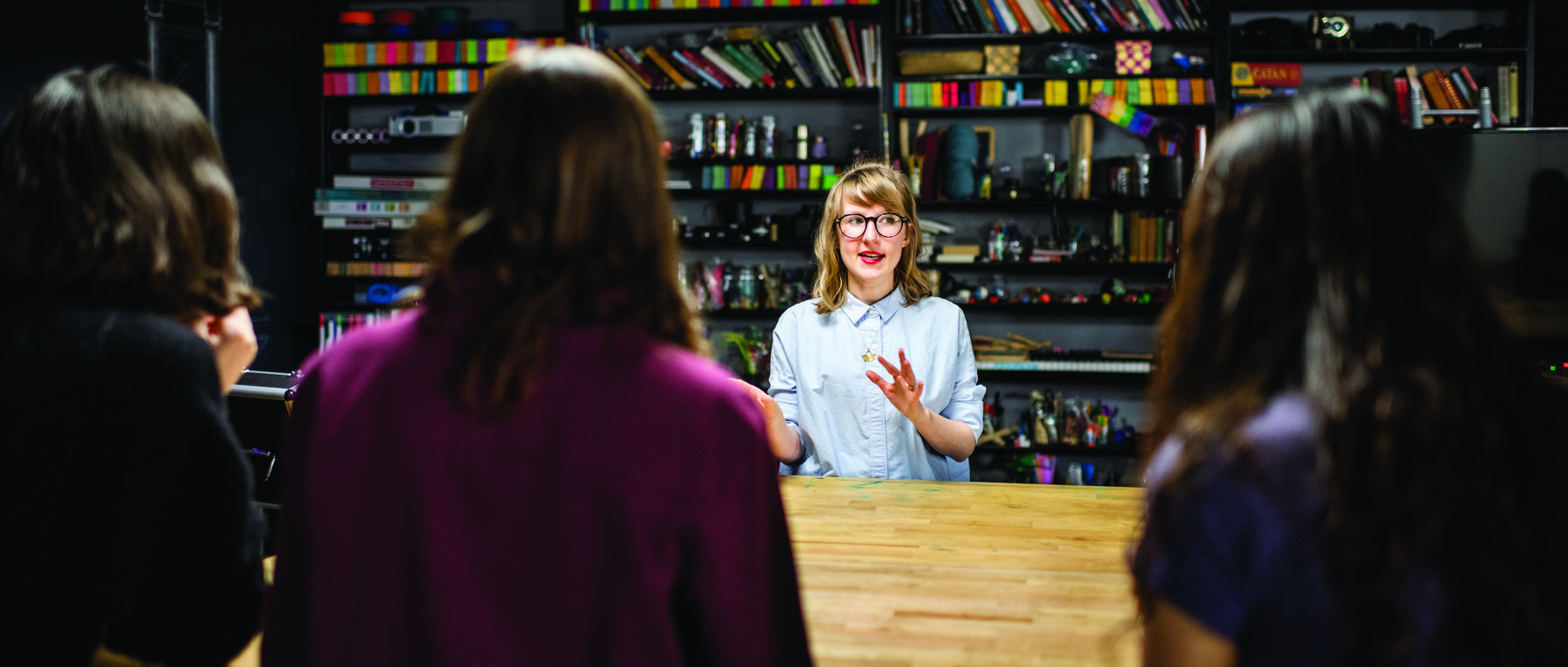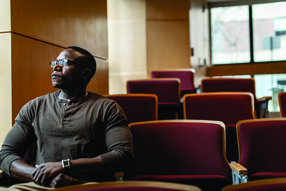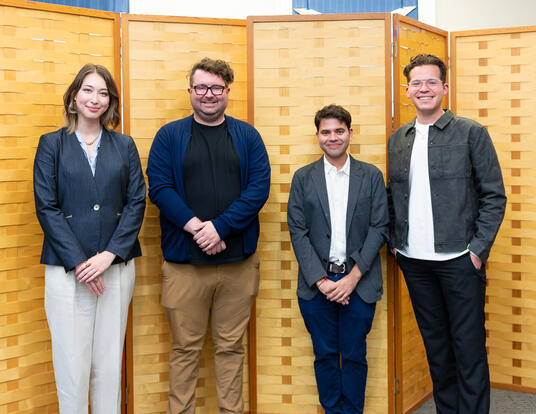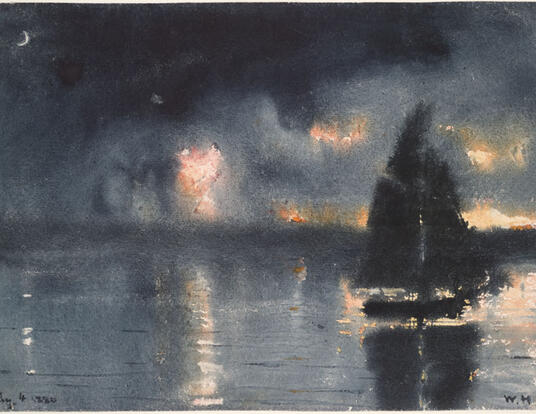Teaching Outside the Box
How Graduate Students Take Different Approaches to the Art-- and Science-- of Teaching

For many, the path to becoming a scholar and teacher is full of challenges: What’s the best way to engage students? What’s the most compelling way to present complicated ideas in the classroom? How can a class continue to influence students after the semester is over? As they contemplated their approaches to teaching, GSAS students Caitlin Schmid and Mobolaji Williams built on their own unique experiences—in Schmid’s case, the time she had to call the fire department to make sure her piano fire didn’t get out of hand.
Creative Approaches
As a fifth-year PhD student in music, Schmid accepted the role of departmental teaching fellow (TF), joining a group of other TFs who met regularly at the Derek Bok Center for Teaching and Learning. There, she participated in workshops that considered a broad range of teaching-related issues, from the mechanics of teaching to giving feedback to developing a teaching philosophy. “I really liked working with the Bok Center and thinking about teaching,” she shares. “I enjoyed connecting with others who are interested in teaching.”
When her time as a departmental TF ended, Schmid missed that connection. She found herself drawn to the Learning Lab, one of the Bok Center’s focus areas, which provides space for developing creative approaches to teaching and learning. Through the Learning Lab, faculty, staff, and students—both graduate students and undergraduates—can explore, design, and build innovative materials, assignments, and activities for Harvard courses.
“The Learning Lab is about teaching, but it involves thinking about the back end of teaching in particular,” she explains. “You design assignments, consider how they will work, and test them with students, all while learning about media and the future of teaching as it’s happening.”

Schmid is no stranger to engaging with course material in a unique way. As a Carleton College undergraduate, she took an introductory music class that included a viewing of the performance music work Piano Burning. The composition is just as it sounds: the burning of a piano, usually an upright model beyond repair. “As I walked out of that class, I thought, ‘We should do that,’” Schmid remembers. She approached her instructor, who supported the idea. Schmid sprang into action, contacting the fire department, writing grants, even inviting composer Annea Lockwood to attend and light the match. Nearly four hundred people watched the two hours it took for the piano to burn.
“Everybody was so excited about it, it made me realize how this kind of music really strikes a chord with people,” says Schmid about avant-garde compositions. “Some people love it. Some people hate it. But it is a really good way to get people talking about what music is and what music means to them.” After earning a master’s from the University of Wisconsin, Madison, she decided to continue her studies at Harvard, where she is focusing her dissertation on 20th-century avant-garde festivals.
Thinking on Their Feet
Schmid’s interest in performance—whether through replicating a performance music piece like Piano Burning or conducting scholarship on festivals—seems ready-made for an approach to teaching that incorporates multimedia tools. “That’s one thing the Learning Lab is particularly good at—figuring out ways to make assignments useful to students while connecting them to digital tools,” she says.
Schmid believes that, while writing is important, media can often do things that writing cannot. “Why not film a project proposal as opposed to writing one? How can a game be effective? What about photography?” she asks. “How can these different media help you reach your teaching goals and enhance what students will get out of it, both in the course and going forward?”
This spring, Schmid will serve as a Learning Lab graduate fellow for “Social Engagement through Music,” a new course that takes a team-based approach to identifying and offering professional support to Boston-area musicians who recently immigrated to the US. While the musicians come from different backgrounds and play different instruments, they are all interested in continuing their diasporic musical traditions, and the students will be responsible for working with the musicians to achieve that goal. They will also learn about the history of immigration in Boston and the history of arts funding, as well as how they can get involved in arts activism.
“This class is going to be amazing,” says Schmid. “The students won’t know what the musicians will need until they engage with them, so some of the class will involve students thinking on their feet.” She expects that students will learn photography, graphic design, film editing, and audio production so that they can take performance photos or produce materials for websites and other platforms designed to increase exposure. Through the Learning Lab, she is developing a series of workshops that will introduce the students to the media they might tap in the course. “We are still thinking about how students can create opportunities for these musicians beyond this semester,” she says. “Maybe through scouting performances, which will involve advertising and marketing skills.”
The Process of Research
While Schmid looks at new media and alternative methodologies as she evolves her teaching philosophy, Mobolaji Williams asks whether curriculum adequately prepares students for the rigors of academic thinking, driven in part by his own experiences with learning.
A native of New Orleans, Williams, a PhD student in physics, had just started high school when Hurricane Katrina struck. His family evacuated to Dallas, where he enrolled in school. “I did well academically in Dallas, which gave me more confidence,” he shares. “I spent time teaching myself geometry, so I would have a head start when I returned to New Orleans.”
Williams did well that semester, which set a precedent for the next few years of high school. “The experience of teaching myself geometry proved that I could teach myself subjects,” he says, “so in 10th grade, I spent spring break learning trigonometry.” When his teacher saw his interest, he lent Williams a calculus textbook, which he used to teach himself the subject over the summer. “At one point, my sister was taking physics, and I wondered if I could learn it, too,” he says. “I went on from there, learning other physics subjects.” This interest in physics led him to apply for MITES, an MIT-based science and engineering program, where he connected with yet another teacher who introduced him to quantum mechanics.

This self-directed learning process drove Williams to question traditional teaching methods, which he felt didn’t prepare students for how physics research is actually pursued. “As I studied physics as an MIT undergraduate, I became increasingly concerned that I wasn’t building the skills needed to work as a physicist,” he says. “Perhaps there is something good about an instructor telling you what problems to solve. But I found it stultifying to learn material I had no personal attachment to.”
When Williams began to conduct research, he realized that the process was quite different from what he had been asked to do in a classroom. He asked himself: What was missing?
“When I was doing research as an undergraduate, sometimes my advisor would give me a very discrete problem similar to a longer, harder problem that one would solve in a class.” Williams explains that he felt comfortable solving these types problems. “But other times, my advisor gave me an idea, and then I needed to come up with questions that could be used to develop a problem, and I had to go on to find a solution to that problem.” Williams felt underprepared for this kind of task—but he learned quickly that this is the process through which research is done. He realized that he needed to transition from an undergraduate answering other people’s questions to a PhD student and professional researcher developing his own. Williams decided to investigate how this transition takes place.
Testing a Theory
When he couldn’t find studies describing this transition, Williams turned to biographies of scientists. From these sources, he came to understand that in a physics class, students are provided well-articulated and precise problems because the teacher wants students to have a box to work within as they find a solution. “But the process of doing research is like the process of building that box,” Williams explains. “You build a framework to pursue a solution to a problem, and the process of developing that framework is extremely non-trivial—which is either delightful or disheartening for a student who’s been taught to solve well-defined problems.”
Over time, Williams kept thinking about this disconnect between the teaching of physics and the pursuit of physics research. After attending a session on academic writing taught by Suzanne Smith, now director of the GSAS Center for Writing and Communicating Ideas, he decided to put his ideas down on paper, focusing on the fact that while physics education develops problem-solving skills for well-defined problems, it lacks practice in identifying gaps in knowledge and in framing those knowledge gaps as questions to be answered. He reached out to Smith, who helped him turn his thoughts into a journal article. In 2018, “The Missing Curriculum in Physics Problem-Solving Education” appeared in Science & Education.

The first time Williams put his ideas to the test was as a TF for an introductory quantum mechanics class, where the professor gave him complete freedom to design sections. Rather than discuss topics introduced by the professor in more detail, he decided to take a different approach. He began each section with a short review before assigning problems and bringing the students together to discuss the solutions. After he felt they had developed sufficient understanding, he would introduce a physical situation, such as a quantum system, and ask them to generate their own questions.
“This process was somewhat difficult because the students were not familiar with this type of assignment, and as a result, their questions were trivial or not sufficiently defined,” he said. “But this is good, I think, for the students. When they ask a question that can be improved upon, you as a teacher can give them feedback, which allows them to ask better questions in the future.”
As Williams has progressed through his graduate studies, he has moved away from teaching toward research in statistical physics, on the combinatorics of biomolecular interactions, in particular. Where once he had struggled to understand the research mindset, he now develops questions designed to identify new knowledge. “In physics, you can propose models which may not have perfect experimental analogs, but which are still useful,” he says. “Properly framed, these models can help build the intuition and mathematical methods needed to study more complicated realistic systems.” Looking ahead, Williams intends to continue with research, to see where it leads. “As long as I’m writing and doing physics, I think I’ll be happy.”
Photography by Jared Leeds
Get the Latest Updates
Join Our Newsletter
Subscribe to Colloquy Podcast
Simplecast





